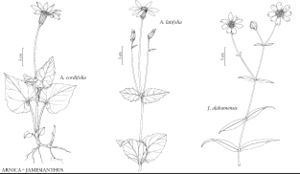Jamesianthus alabamensis
Publ. Field Mus. Nat. Hist., Bot. Ser. 22: 402. 1940.
IllustratedEndemic
Treatment appears in FNA Volume 21. Treatment on page 377.
Stems stipitate-glandular distally, internodes 4–6 (–10) cm. Leaf-blades 50–90 × 10–25 (–40) mm. Peduncles 4–8+ cm. Phyllaries: outer ± oblong to ovate, 2–4+ mm, inner ovate-oblong to ovate-attenuate, 7–9 mm; all ± stipitate-glandular abaxially. Ray laminae 10–15+ mm. Disc corollas 5–6 mm, tubes stipitate-glandular. Cypselae 3–4 mm; pappus bristles 4–5 mm.
Phenology: Flowering Aug–Oct.
Habitat: Shaded places, limestone outcrops
Elevation: 70–200 m
Discussion
Selected References
None.
Lower Taxa
None.
"broader" is not a number.
... more about "Jamesianthus alabamensis"
glabrous +
hirtellous +
scabrellous +
introrse +
connate +
herbaceous +
scarious +
absent +
hirsute +
papillate +
continuous +
decurrent +
less lanceolate;narrowly trullate +
winged;ribbed;winged;ribbed +
1;15 +
stigmatic +
absent +
zygomorphic +
yellow +
monomorphic +
dimorphic +
3mm;4mm +
staminate +
inner +
bisexual +
hispidulous +
staminate +
Ala. +
straight +
scabrellous +
distinct +
proximal +
1;5 +
bisexual +
dispersed +
singly +
discoid +
indeterminate +
Present +
surrounding +
campanulate +
10mm;25mm +
opposite +
cauline +
2-carpellate +
inferior +
attached +
anatropous +
persistent +
fragile +
falling +
absent +
aristate +
tough +
thick +
absent +
connate +
persistent +
distinct +
falling +
stipitate-glandular +
unequal +
Publ. Field Mus. Nat. Hist., Bot. Ser. +
1940 +
pistillate +
absent +
fertile +
16-24-nerved +
hispidulous +
epaleate +
pitted +
flat;convex +
fibrous +
distinct +
exalbuminous +
modifed +
alternate +
stipitate-glandular +
2-branched +
papillate +
Jamesianthus alabamensis +
Jamesianthus +
species +
longer +
stipitate-glandular +
perennial +

